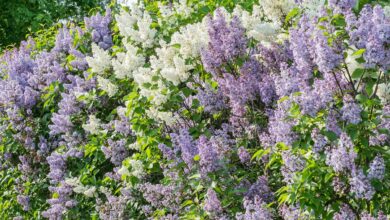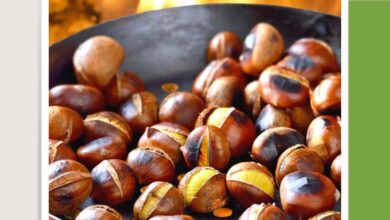7 Sustainable Trends To Take From RHS Chelsea Flower Show
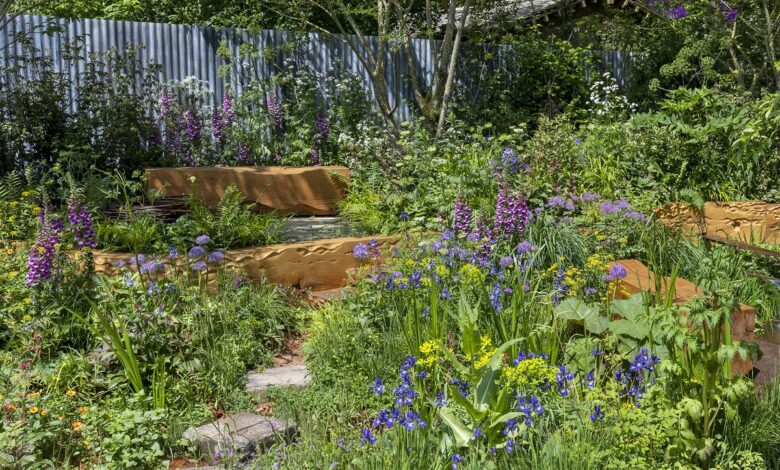
[ad_1]
One of the most prestigious gardening events in the world, the UK’s RHS Chelsea Flower Show is a wonderful showcase of garden design and innovation.
The show hosts dozens of stunning gardens created by leading designers and offers a fantasy shopping spree for the most beautiful and unique plants.
Part of Chelsea’s charm is its distinctly English feel, yet many of the show gardens present ideas with global appeal.
Sustainable gardening is an overarching theme in 2024, with every scheme incorporating eco-conscious design considerations and thoughtful plant choices.
There is plenty to learn from this year’s crop of show gardens. Here, we highlight the top sustainable trends to take inspiration for your own garden.
1. Keyhole Raised Beds
(Image credit: RHS / Sarah Cuttle)
Originating from Africa, keyhole raised beds are an ingenuous concept for those living in dry climates and areas of poor soil. They are also ideally suited to small spaces – although, all gardeners can benefit from them.
Commonly seen in permaculture gardens, keyhole raised beds are built using blocks or stones in a circular form so they can be accessed from all sides. However, they get their name from a cutout section in their design, which enables a composting cage to be positioned at the center. This is filled with yard clippings and kitchen scraps.
This central section is also where the beds are watered, so that, as the waste decomposes, the water absorbs the nutrients before soaking into the soil. The clever raised bed structure is water-retentive, allowing just enough drainage, meaning they won’t require regular watering.
Keyhole beds are suitable for a wide variety of vegetables, herbs, and perennial plants, as they can accommodate deep roots.
For Chelsea Flower Show, designer Giulio Giorgi developed unique 3D-printed terracotta interlocking blocks that allow raised beds to be built in a Lego-like fashion, without the use of concrete or chemical glues. These are on show in the World Child Cancer’s Nurturing Garden, and filled with low-maintenance, resilient plants.
2. Next-Level Rainwater Harvesting
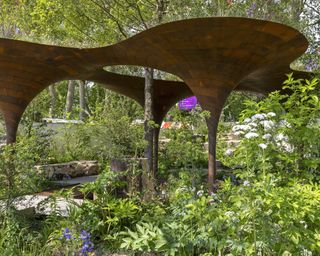
(Image credit: RHS / Neil Hepworth)
Many of this year’s show gardens highlight the importance of collecting rainwater – but none are as impressive as the WaterAid Garden, which houses a huge sculptural rainwater harvesting pavilion.
As well as providing shade, the pavilion collects, filters, and stores every drop of rainwater for later use. Every surface in the garden is permeable, allowing water to pass through.
While a sculptural pavilion offers a high-end solution to managing rainwater, other schemes offer slightly more accessible ideas. In Flood Re: The Flood Resilient Garden, large repurposed tanks collect water via rain chains – which are both stylish and functional (see lead image). The tanks double as an attractive water feature, and the water can be used in the garden when needed using smart technology.
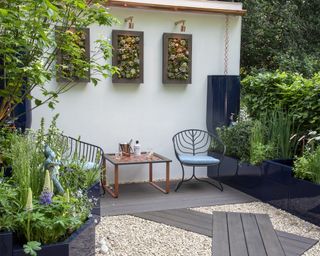
(Image credit: RHS / Tim Sandall)
Elsewhere, the contemporary courtyard Water Saving Garden features numerous simple ways in which water can be harvested and reused, including slimline butts, rain sensors, and sleek interconnected self-watering planters fed with the collected rainwater.
Many of the gardens also highlight the importance of using permeable surfaces and rainwater collection ponds or streams to slow down water run-off.
3. Green Sanctuaries For Urban Areas
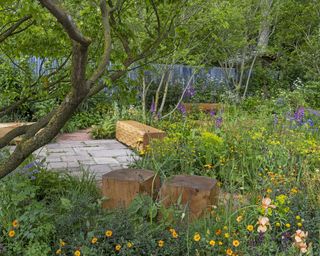
(Image credit: RHS / Neil Hepworth)
“The healthy gift of air and the joy of plants and flowers” are vital for everyone, believed social reformer Octavia Hill. In the Octavia Hill Garden, an urban community wildlife garden is designed to improve well-being, increase biodiversity, and allow visitors to connect with plants and wildlife.
Pollinator-friendly plants, bird boxes, a contemporary wildlife pond, and walkable stream create a welcome home for local wildlife.
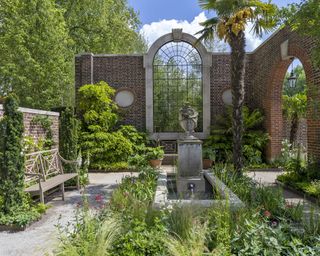
(Image credit: RHS / Neil Hepworth)
Over in St James’s Piccadilly: Imagine the World to be Different, a lush, biodiverse planting scheme has created an urban sanctuary for city dwellers and wildlife alike.
The show garden celebrates the revitalizing power of urban green spaces, and cleverly shows how even a formerly bomb-damaged site can become a green, harmonious space, thanks to nature’s resilience.
4. Greening Up The Smallest Spaces
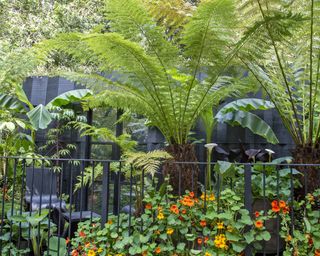
(Image credit: RHS / Tim Sandall)
Chelsea Flower Show’s Balcony & Container Gardens section explores the many ways in which even the smallest outdoor areas can become an urban oasis.
The Addleshaw Goddard Junglette Garden is a tropical enclave that shields residents from the urban jungle and shows that an explosion of biodiversity is possible on a balcony.
Hardy tropical planting mimics the layers of a jungle, while the balcony’s inner city location allows more tender species to thrive outdoors.
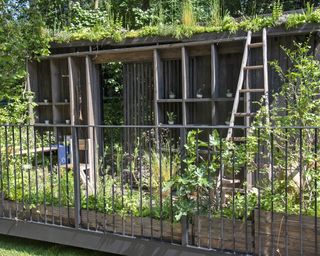
(Image credit: RHS / Tim Sandall)
At Tomie’s Cuisine the Nobonsai garden, a no-waste philosophy is on show, highlighting “dig and drop” composting, where spent plants, pruned, twigs, and pulled weeds are placed directly onto the soil.
Recycled cardboard and newspaper are also integrated into the garden, with a result that the plants rarely require watering.
5. Landscaping That Adapts To Climate Change
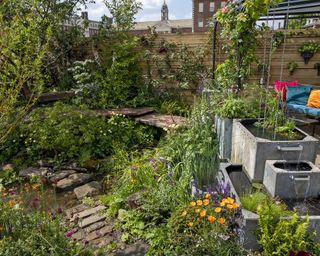
(Image credit: RHS / Sarah Cuttle)
Many of the gardens at Chelsea Flower Show 2024 focus on landscaping schemes that stand up to climate change.
Flood Re: The Flood Resilient Garden offers a clever solution to flooding by integrating a central swale – or feature pond – that draws rainwater away from other areas of the garden, allowing for swift recovery after heavy rainfall.
Dense planting is used around the garden to slow the flow of water, and planting is thoughtfully considered, with species that thrive in boggy conditions planted lower into the swale, while those that require drained soil are located on higher ground.
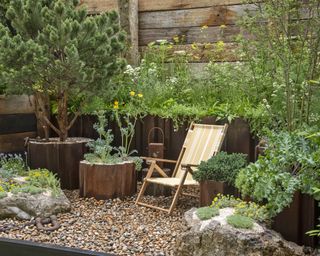
(Image credit: RHS / Tim Sandall)
Elsewhere, mgr Changing Tides Garden is a coastal garden that features storm-resilient plants that have adapted to the harsh conditions along the shoreline.
Ragstone boulders are hand-sculpted into planters, while the protective boundary is made from reclaimed weathered timber to evoke the feeling of dramatic coastal weather.
Meanwhile, The National Garden Scheme Garden presents a palette of drought-tolerant woodland plants, selected to cope with clay soil prone to drying out.
6. Multitasking Trees
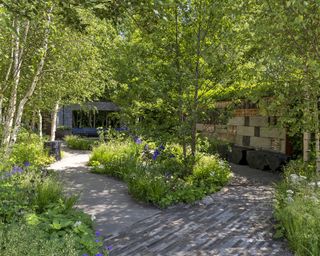
(Image credit: RHS / Neil Hepworth)
Trees are widely celebrated at this year’s show, and feature in most of the gardens. Small trees show how even balcony gardens can have a slice of nature, taller trees provide a canopy for understory planting, and climate-resilient trees demonstrate the importance of creating adaptable schemes.
In the WaterAid Garden, the remarkable properties of alder trees are highlighted. Alder can survive being submerged in water and its nitrogen-capturing roots are able to absorb toxic heavy metals, helping to restore contaminated soils.
Meanwhile, the Muscular Dystrophy UK – Forest Bathing Garden has more than 40 birch trees under-planted with woodland edge-style plants, varying from deep shade corners to open woodland glades.
7. A Sustainable Materials Palette
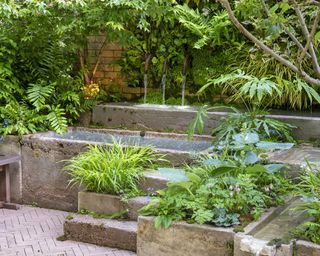
(Image credit: RHS / Tim Sandall)
Across the show, exhibitors have taken a sensitive approach to materials choice. Peat-free compost, minimal use of chemicals, no plastic, and locally sourced wood are key to many garden designs.
At the Eco Therapy Garden, innovative containers have been made from lightweight, sustainable hypertufa. Usually, it contains peat soil, but instead, Perlite, coconut coir, and cement create a more sustainable method of constructing a hardwearing planter that will last for over 30 years.
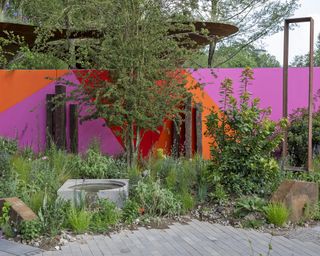
(Image credit: RHS / Sarah Cuttle)
Reusing and recycling is also a key theme across the show. At RHS Chelsea Repurposed, key elements from show gardens dating back as far as 2010 have been reused with some creative recycling – from water features to seating, and sculpture.
Even crushed concrete and sand salvaged from demolished buildings have been used as a planting medium for grasses and local wildflowers.
The gardens show that recycling doesn’t just save money and the planet, but creates a more unique, characterful design.
[ad_2]
Source link




